Guest
Guest
 |  Subject: Has Comet Sliding Spring changed Mars' atmosphere forever? 'Meteoric smoke' from flyby may have altered Martian chemistry Subject: Has Comet Sliding Spring changed Mars' atmosphere forever? 'Meteoric smoke' from flyby may have altered Martian chemistry  Fri Nov 28, 2014 8:13 am Fri Nov 28, 2014 8:13 am | |
| Has Comet Sliding Spring changed Mars' atmosphere forever? 'Meteoric smoke' from flyby may have altered Martian chemistry
- Mars played host to extremely rare Oort Cloud comet flyby in October
- The speeding comet produced a huge meteor storm on the red planet
- Nasa says chemistry of Mars may have changed due to comet's dust
- Dust may produce high-clouds changing Mars' interaction with the sun
- Studying Siding Spring may offer insights into solar system formation
By ELLIE ZOLFAGHARIFARD FOR MAILONLINEPUBLISHED: 07:20 EST, 28 November 2014 | UPDATED: 07:26 EST, 28 November 2014Mars recently played host to an Oort Cloud comet flyby, providing an unprecedented chance to expand our understanding of the solar system.Siding Spring passed within 87,000 miles (140,000 km) of Mars, less than half the distance between Earth and its moon, and much closer than any comet has ever come to Earth.Now, Nasa has released data suggesting that the chemistry of Mars' atmosphere could be changed forever from the flyby, which only happens once every eight million years.Scroll down for video 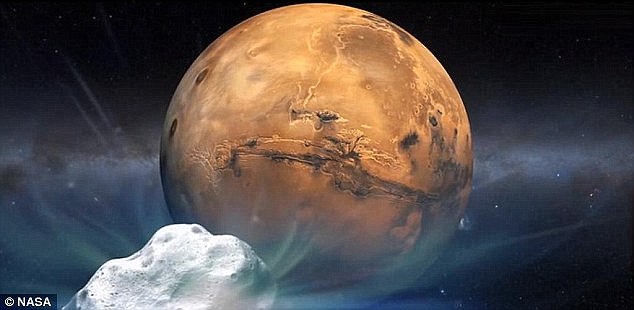 +6Mars recently played host to an Oort Cloud comet flyby, providing an unprecedented chance to expand understanding of our solar system. Siding Spring passed within 87,000 miles (140,000 km) of Mars (artist's impression pictured in a flyby which only happens once every eight million yearsThe comet's dust likely produced a meteor shower when particles hit it the upper atmosphere, 'literally changing the chemistry,' said Jim Green, director of Nasa's planetary science division.As well as adding a new layer of ions to the Mars atmosphere, the speeding comet - which travelled at 35 miles per second (56km per second) - produced what was described as a meteor storm.Experts describe the scene, with thousands of shooting stars per hour and the entire sky changing colour as 'mind blowing'.'It's extremely rare in human history. It would have been truly stunning to the human eye,' said planetary scientist Nick Schneider, with the University of Colorado in Boulder. +6Mars recently played host to an Oort Cloud comet flyby, providing an unprecedented chance to expand understanding of our solar system. Siding Spring passed within 87,000 miles (140,000 km) of Mars (artist's impression pictured in a flyby which only happens once every eight million yearsThe comet's dust likely produced a meteor shower when particles hit it the upper atmosphere, 'literally changing the chemistry,' said Jim Green, director of Nasa's planetary science division.As well as adding a new layer of ions to the Mars atmosphere, the speeding comet - which travelled at 35 miles per second (56km per second) - produced what was described as a meteor storm.Experts describe the scene, with thousands of shooting stars per hour and the entire sky changing colour as 'mind blowing'.'It's extremely rare in human history. It would have been truly stunning to the human eye,' said planetary scientist Nick Schneider, with the University of Colorado in Boulder.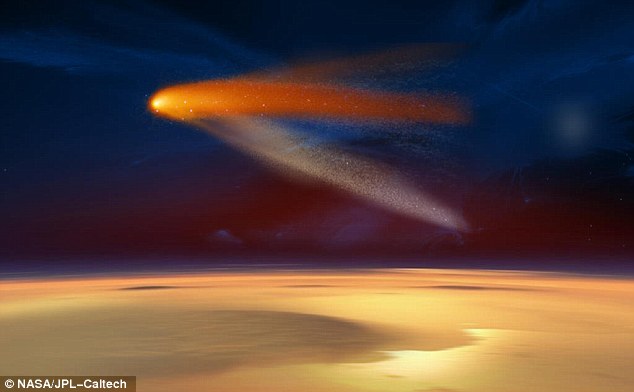 +6The comet's dust produced a meteor shower when particles hit it the upper atmosphere, 'literally changed the chemistry,' said Jim Green, director of Nasa's planetary science division (artist's impression pictured) +6The comet's dust produced a meteor shower when particles hit it the upper atmosphere, 'literally changed the chemistry,' said Jim Green, director of Nasa's planetary science division (artist's impression pictured) COMET SIDING SPRING'S 'MINDBLOWING' ENCOUNTER WITH MARSComet Siding Spring comes from the Oort Cloud, material left over from the formation of the solar system. 'This comet is coming into the solar system straight from the Oort Cloud. It's likely this is its first time this close to the sun,' said space scientist David Humm, of the Johns Hopkins University Applied Physics Laboratory (APL) in Laurel, Maryland.Oort Cloud material, including comets, is scattered through a vast region that begins outside the orbits of Neptune and Pluto and extends a substantial fraction of the distance to Proxima Centauri, the closest neighboring star. Oort Cloud comets can tell scientists about the materials - including water and carbon compounds - that existed during the formation of the solar system some 4.6 billion years ago.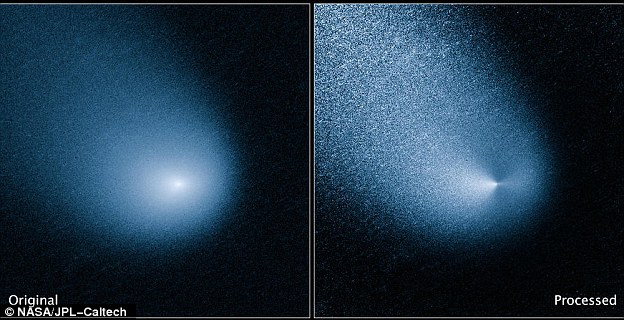 +6The images above show - before and after filtering - comet C/2013 A1, also known as Siding Spring, as captured by Wide Field Camera 3 on NASA's Hubble Space TelescopeStudying this close encounter was the largest fleet of orbiting scientific observatories ever flown to another world, orbiting around (and rolling on the ground of) Mars.These instruments will, for the first time ever, have the chance to make close-up observations of a comet new to the inner solar system. And though it will not be the easiest task, the teams operating these instruments and spacecraft have developed plans to take advantage of this rare opportunity.Siding Spring is small (the nucleus is less than a mile in diameter) and fast (it passed Mars at about 34 miles/55 kilometres per second).The instruments on various spacecraft observed the comet repeatedly for two and a half days as it got closer and closer to Mars before it made its closest approach.The peak density of comet dust at Mars was expected 98 minutes after closest approach of the nucleus. +6The images above show - before and after filtering - comet C/2013 A1, also known as Siding Spring, as captured by Wide Field Camera 3 on NASA's Hubble Space TelescopeStudying this close encounter was the largest fleet of orbiting scientific observatories ever flown to another world, orbiting around (and rolling on the ground of) Mars.These instruments will, for the first time ever, have the chance to make close-up observations of a comet new to the inner solar system. And though it will not be the easiest task, the teams operating these instruments and spacecraft have developed plans to take advantage of this rare opportunity.Siding Spring is small (the nucleus is less than a mile in diameter) and fast (it passed Mars at about 34 miles/55 kilometres per second).The instruments on various spacecraft observed the comet repeatedly for two and a half days as it got closer and closer to Mars before it made its closest approach.The peak density of comet dust at Mars was expected 98 minutes after closest approach of the nucleus.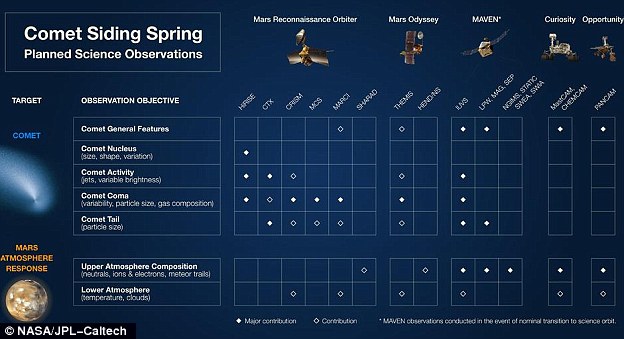 +6This graphic shows the science observations that was hoped to be captured by Nasa's Mars spacecraft during the close encounter with Comet Siding Spring (C/2013 A1)Although the comet eventually left Mars far behind, its impact could have long-standing effects on the planet, claims Elizabeth Howell in Universe Today.Instruments on Maven detected eight different types of metal ions in the comet dust: sodium, magnesium, potassium, chromium, manganese, iron, nickel, and zinc.Nasa says that eventually these metals will revert to dust in a process known as meteoric smoke.The introduction of all of this new dust into the Mars atmosphere may produce high-altitude clouds above the planet's surface and could affect its interaction with sunlight. +6This graphic shows the science observations that was hoped to be captured by Nasa's Mars spacecraft during the close encounter with Comet Siding Spring (C/2013 A1)Although the comet eventually left Mars far behind, its impact could have long-standing effects on the planet, claims Elizabeth Howell in Universe Today.Instruments on Maven detected eight different types of metal ions in the comet dust: sodium, magnesium, potassium, chromium, manganese, iron, nickel, and zinc.Nasa says that eventually these metals will revert to dust in a process known as meteoric smoke.The introduction of all of this new dust into the Mars atmosphere may produce high-altitude clouds above the planet's surface and could affect its interaction with sunlight.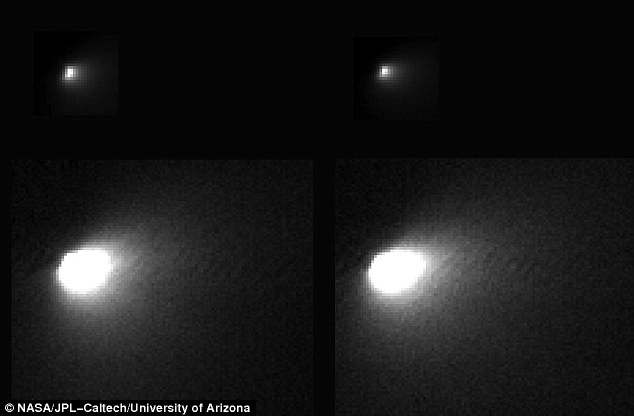 +6These images were taken of comet C/2013 A1 Siding Spring by Nasa's Mars Reconnaissance Orbiter on 19 October 2014 during the comet's close flyby of Mars and the spacecraft. It is the highest-resolution image of a comet that heralds from the Oort Cloud at the edge of the solar system ever takenhttp://www.dailymail.co.uk/sciencetech/article-2852946/Has-Comet-Sliding-Spring-changed-Mars-atmosphere-forever-Meteoric-smoke-flyby-altered-Martian-chemistry.html#v-3833077343001 +6These images were taken of comet C/2013 A1 Siding Spring by Nasa's Mars Reconnaissance Orbiter on 19 October 2014 during the comet's close flyby of Mars and the spacecraft. It is the highest-resolution image of a comet that heralds from the Oort Cloud at the edge of the solar system ever takenhttp://www.dailymail.co.uk/sciencetech/article-2852946/Has-Comet-Sliding-Spring-changed-Mars-atmosphere-forever-Meteoric-smoke-flyby-altered-Martian-chemistry.html#v-3833077343001
Comet Siding Spring to narrowly miss the red planet As well as this, the chemistry of the atmosphere might be permanently altered.The comet was a rare visitor from the Oort Cloud, a spherically shaped reservoir beyond Neptune's orbit containing leftovers from the formation of the solar system some 4.6 billion years ago.The interest in examining the properties of the comet dust doesn't end with its effects on Mars.'We believe that comets were formed very early, much earlier than the Earth was,' Mr Green said.Studying Siding Spring may offer unique insight into the content of the collapsing cloud that formed the solar system, he said.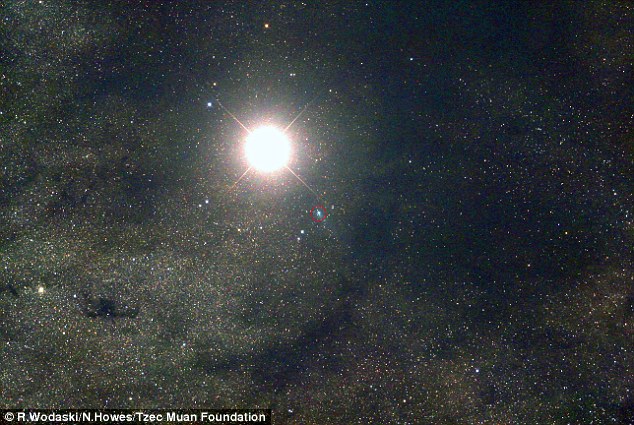 +6This image of Comet Siding Spring was taken by astronomers Nick Howes and Ron Wodaski using the Tzec Muan Observatory in Australia. The comet is the blue-ish object towards the middle of the picture, with its tail seen streaking backwards. Mars is the bright sun-like object in the middle, overexposed to reveal the comet Read more: +6This image of Comet Siding Spring was taken by astronomers Nick Howes and Ron Wodaski using the Tzec Muan Observatory in Australia. The comet is the blue-ish object towards the middle of the picture, with its tail seen streaking backwards. Mars is the bright sun-like object in the middle, overexposed to reveal the comet Read more:
- ‘Meteoric Smoke': Comet Siding Spring Could Alter Mars Chemistry Permanently
Read more: http://www.dailymail.co.uk/sciencetech/article-2852946/Has-Comet-Sliding-Spring-changed-Mars-atmosphere-forever-Meteoric-smoke-flyby-altered-Martian-chemistry.html#ixzz3KN96cL5f
|
|





